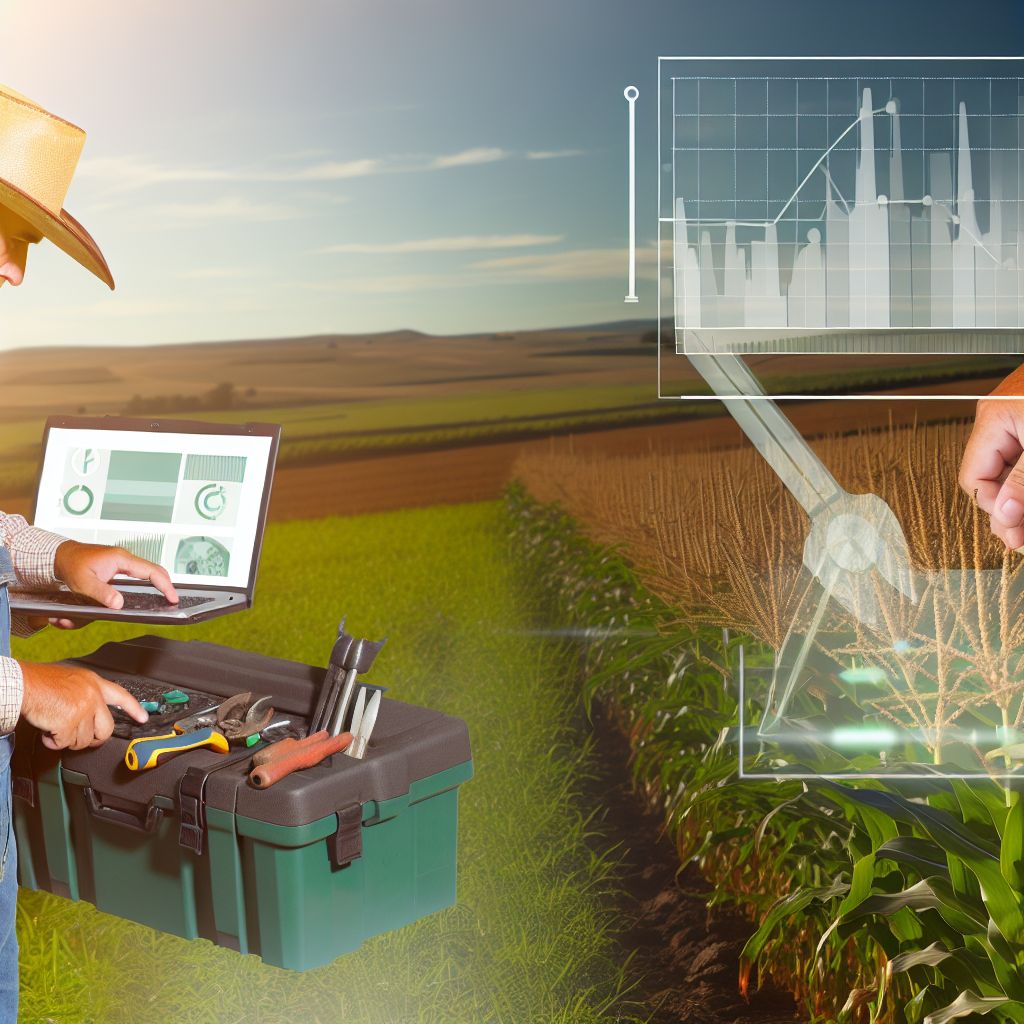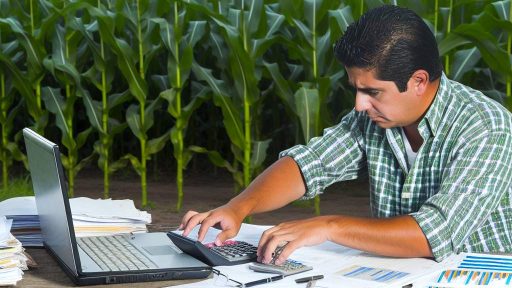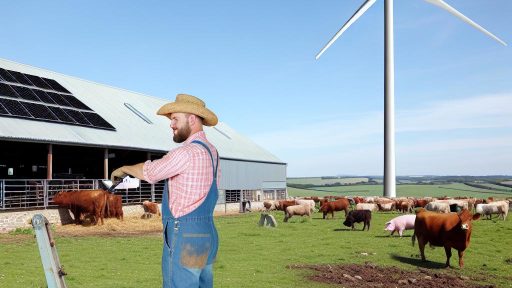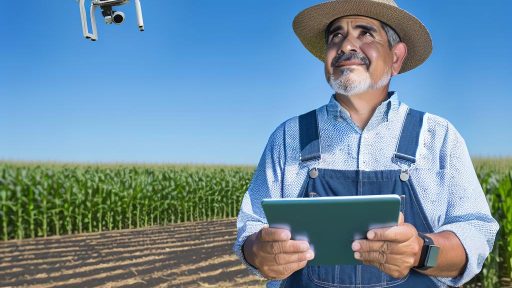Introduction to Drones in Agriculture and Their Role in Harvesting
Drones are revolutionizing the field of agriculture.
These unmanned aerial vehicles enhance various farming practices.
Farmers can utilize drones to improve harvest accuracy significantly.
They provide real-time data on crop health and conditions.
Drone technology offers precision in monitoring large fields.
Moreover, they help farmers make informed decisions quickly.
Enhancing Data Collection
Drones efficiently collect agricultural data from above.
This data includes information about plant health, moisture levels, and nutrient deficiencies.
Farmers can visualize this data through aerial imagery.
Consequently, they can identify specific areas that require attention.
This targeted approach optimizes resource allocation considerably.
Increasing Efficiency in Harvesting
Using drones can streamline the harvesting process.
They can monitor crop readiness in real-time.
With drone technology, farmers can reduce labor costs significantly.
Additionally, drones expedite the decision-making process.
Transform Your Agribusiness
Unlock your farm's potential with expert advice tailored to your needs. Get actionable steps that drive real results.
Get StartedBy assessing which areas are ripe for harvest, efficiency improves.
Supporting Sustainable Practices
Drones contribute to sustainable farming practices.
By minimizing resource usage, they support environmental conservation.
This technology allows for precise application of fertilizers and pesticides.
As a result, farmers can reduce chemical runoff into waterways.
This practice encourages healthier ecosystems and promotes biodiversity.
Challenges and Considerations
Despite their benefits, drones face challenges in agriculture.
Regulatory restrictions can hinder their widespread adoption.
Additionally, initial costs may be prohibitive for small farms.
Farmers must also ensure they are trained in drone operation.
Addressing these challenges will pave the way for wider adoption.
Types of Drones Used in Agriculture
Overview of Agricultural Drones
Drones play a significant role in modern agriculture.
They enhance efficiency and accuracy on farms.
Farmers utilize different types of drones based on specific needs.
This section explores various drone types and their applications.
Multirotor Drones
Multirotor drones feature several rotating blades.
They are easy to maneuver and control.
Farmers often use them for small areas requiring detailed inspections.
These drones provide valuable insights into crop health.
Their ability to hover allows for precise data collection.
Fixed-Wing Drones
Fixed-wing drones resemble small airplanes.
They cover larger areas more efficiently than multirotor drones.
These drones are ideal for surveying vast fields.
They can fly longer distances due to their aerodynamic design.
Showcase Your Farming Business
Publish your professional farming services profile on our blog for a one-time fee of $200 and reach a dedicated audience of farmers and agribusiness owners.
Publish Your ProfileFarmers benefit from improved mapping and analysis capabilities.
Hybrid Drones
Hybrid drones combine features of both multirotor and fixed-wing designs.
This versatility allows them to take off and land vertically.
They can adapt to various farming tasks effectively.
Farmers appreciate their flexibility and increased functionality.
These drones excel in inspections, mapping, and monitoring.
Payload Drones
Payload drones carry additional equipment, such as cameras and sensors.
Farmers use them for specific tasks, including spraying pesticides.
This allows for precise application of fertilizers and chemicals.
The use of payload drones promotes resource efficiency.
They help minimize waste and enhance yield quality.
Survey Drones
Survey drones focus on data collection for analysis.
They capture high-resolution imagery and video.
This information assists farmers in making informed decisions.
Survey drones provide insights into soil health and crop conditions.
Moreover, they help identify pest infestations early.
Implications of Drone Types for Agriculture
Understanding the types of drones is crucial for modern farming.
Each type offers unique benefits and applications.
Farmers should evaluate their specific needs when selecting drones.
Utilizing the right drones can significantly enhance agricultural outcomes.
How Drones Improve Harvest Accuracy
Technology Behind Drone Usage
Drones utilize advanced imaging technology for precise monitoring.
This technology includes multispectral and hyperspectral sensors.
These sensors gather essential data about crop health.
Consequently, farmers can make informed decisions quickly.
Additionally, drones incorporate GPS technology for accurate mapping.
This mapping ability identifies variations across fields efficiently.
As a result, farmers can target specific areas for treatment.
Methods of Data Collection
Drones collect data through aerial surveys and imaging.
Aerial surveys capture detailed photos of diverse landscapes.
These photos reveal crop conditions and moisture levels.
In addition, drones can perform vegetation index calculations.
This advanced technique helps in assessing plant health.
Farmers can leverage this data to optimize harvest timings.
Improving Precision in Harvesting
Utilizing drones enhances the accuracy of harvest prediction.
Farmers benefit from better insights into yield estimation.
This precision helps in planning logistics effectively.
Moreover, targeted interventions reduce waste and costs.
Consequently, farmers can maximize their profits and resources.
Real-World Examples of Drone Implementation
Several farms have successfully integrated drones into their operations.
For instance, Green Valley Farms uses drones for aerial imagery.
Showcase Your Farming Business
Publish your professional farming services profile on our blog for a one-time fee of $200 and reach a dedicated audience of farmers and agribusiness owners.
Publish Your ProfileThis imaging helps them monitor crop growth over time.
Similarly, Berry Hill Organic Farm employs drones for pest detection.
These practical applications showcase the benefits of drone technology.
Overall, these farms experience increased efficiencies and yields.
Uncover the Details: Smart Irrigation Systems Powered By AI
Case Studies: Successful Implementation of Drones in Various Crops
Corn Farming Innovations
Corn farming has embraced drone technology for precision agriculture.
For instance, Green Valley Farms started using drones two years ago.
They collect aerial images to assess crop health efficiently.
This practice enables farmers to detect irrigation issues quickly.
As a result, overall corn yield has increased by 15%.
Rice Cultivation Advancements
In the rice-growing regions of Louisiana, drones play a critical role.
RiceTech Solutions utilizes drones to monitor fields remotely.
The company successfully tracks water levels in paddies.
This data-driven approach minimizes water wastage each season.
Consequently, this led to a 20% decrease in operational costs.
Wheat Field Monitoring
Wheat producers in the Midwest are reaping benefits from drone use.
AgriVision has implemented aerial surveillance for field assessments.
These drones detect pest infestations before they escalate.
Farmers can apply targeted pest control measures more effectively.
As a result, they report better crop quality and higher profits.
Fruit Orchard Management
In California’s orchards, drone technology enhances management practices.
Fruitful Orchards deployed drones for tree health analysis.
This method allows for early identification of diseases in trees.
Additionally, it provides insights into optimal harvest times.
Consequently, they witnessed a 25% increase in apple production.
Various crops have benefited significantly from drone technology.
Farmers reduce waste while increasing yields across the board.
This technology aids in sustainable agricultural practices.
Thus, drones are becoming essential tools for modern agriculture.
Uncover the Details: Blockchain Innovations Driving Efficiency In Farming Supply Chains
Cost-Benefit Analysis: Investing in Drone Technology for Farmers
The Initial Investment
Farmers must first consider the cost of purchasing drones.
Drones vary in price based on features and specifications.
A basic model can cost around $1,000, while more advanced ones may exceed $5,000.
Farmers also need to budget for maintenance and repairs.
Insurance is another expense to account for in the overall investment.
Operational Benefits
Drones significantly enhance field mapping efficiency.
They provide accurate, real-time data on crop health.
This data helps farmers make informed decisions about their fields.
With drones, monitoring large agricultural areas becomes less time-consuming.
Farmers can quickly identify problem areas needing attention.
Showcase Your Farming Business
Publish your professional farming services profile on our blog for a one-time fee of $200 and reach a dedicated audience of farmers and agribusiness owners.
Publish Your ProfileImproved Yield and Quality
Implementing drone technology can lead to higher yields.
Drones enable precise application of fertilizers and pesticides.
This targeted approach minimizes waste and increases efficiency.
Checking plant health regularly can prevent crop losses.
As a result, quality of produce significantly improves.
Long-Term Financial Gains
Despite the initial investment, long-term gains are substantial.
Farmers can expect a return on investment through increased productivity.
Enhanced efficiency lowers operational costs over time.
A higher yield can lead to greater market opportunities.
Ultimately, this technology can improve overall farm profitability.
Challenges to Consider
While drones offer many benefits, challenges remain.
Farmers must navigate regulatory requirements for drone use.
Training staff to operate drones is necessary and adds to costs.
Technical issues can arise, requiring troubleshooting and repair.
Farmers should also consider the learning curve associated with new technology.
Implications of Drone Technology in Agriculture
Investing in drone technology can reshape farming.
Despite challenges, the potential rewards are compelling.
Farmers who embrace this technology may lead the future of agriculture.
Explore Further: Security Considerations When Choosing Farm Management Software

Challenges and Limitations of Using Drones in Agriculture
Regulatory Hurdles
Agricultural drone usage faces numerous regulatory challenges.
Governments impose strict regulations on airspace use.
Farmers must obtain permits before flying drones.
This process often leads to delays in implementation.
Furthermore, compliance with local laws can be complex.
Technical Limitations
Drones have limitations related to battery life.
A typical drone can only fly for about 30 minutes.
High-resolution imaging requires significant power.
Additionally, inclement weather can affect drone operation.
Wind and rain can limit flying capabilities drastically.
Data Management Issues
Drone technology generates substantial amounts of data.
Managing and analyzing this data requires expertise.
Farmers may struggle with software integration.
Data storage capacity also poses significant challenges.
Consequently, many farmers find it overwhelming.
Cost Concerns
Investing in drone technology can be expensive.
High-quality drones and sensors require significant financial investment.
Moreover, maintenance and operation costs can add up.
Some farmers may find the initial costs prohibitive.
This can limit accessibility to advanced drone technology.
Skill Gaps Among Farmers
Many farmers lack the technical skills necessary for drone operation.
Showcase Your Farming Business
Publish your professional farming services profile on our blog for a one-time fee of $200 and reach a dedicated audience of farmers and agribusiness owners.
Publish Your ProfileTraining programs are often limited in rural areas.
Consequently, the technology remains underutilized.
Farmers may also face challenges in interpreting drone data.
Education on the technology is crucial for effective use.
Gain More Insights: Ethical Considerations In Agricultural Biotechnology
Future Trends: Innovations and Developments in Agricultural Drones
Emerging Technologies
Recent advancements are transforming agricultural drones into more powerful tools.
Next-generation sensors enhance data accuracy and collection efficiency.
Moreover, AI integration allows for precision management of agricultural operations.
These technologies improve decision-making and reduce resource waste.
Data Analysis Capabilities
Advanced drones now offer sophisticated data analysis capabilities.
Farmers can access real-time analytics for crop health monitoring.
This access enables timely interventions and optimized growth strategies.
Consequently, farmers maintain healthier crops and increase potential yields.
Regulatory Developments
Regulation in drone use is evolving to ensure safe operation.
New guidelines will accommodate the expanding use of drones in agriculture.
Future regulations may include easier flight permissions for farmers.
These changes will likely encourage broader adoption of drone technology.
Market Growth and Accessibility
The agricultural drone market is experiencing substantial growth.
Increased competition leads to more affordable drone options for farmers.
As a result, small and medium-sized farms can access innovative technologies.
Consequently, this trend promotes wider technology adoption.
Integration with Other Agricultural Technologies
There is a growing trend to integrate drones with other agricultural tools.
For instance, drones now work alongside IoT devices for farm management.
This integration enhances resource management and overall efficiency.
Farmers can achieve a comprehensive overview of their operations.
Regulatory Considerations and Best Practices for Drone Use in Farming
Understanding Drone Regulations
Drone regulations play a crucial role in agricultural practices.
Farmers must understand local and national laws.
These laws govern flight altitudes, no-fly zones, and usage times.
Additionally, compliance ensures safety for both operators and the public.
Farmers should regularly review updates on regulations.
Licensing and Certification
Obtaining the necessary licenses is essential for drone operation.
Farmers need Remote Pilot Certificates from the Federal Aviation Administration (FAA).
This certification includes training on airspace regulations and safety measures.
Moreover, specific certifications may be required based on drone type and use.
Implementing Best Practices
Adopting best practices enhances the effectiveness of drone use.
Farmers should conduct thorough pre-flight inspections of equipment.
Additionally, maintaining a flight log improves accountability and performance tracking.
Utilizing advanced software can optimize flight plans and data collection.
Environmental Considerations
Farmers must consider the ecological impact of drone use.
Minimizing disruptions to wildlife is crucial during flying operations.
Showcase Your Farming Business
Publish your professional farming services profile on our blog for a one-time fee of $200 and reach a dedicated audience of farmers and agribusiness owners.
Publish Your ProfileFurthermore, drones should not interfere with local agricultural processes.
Using drones responsibly can further support sustainable farming efforts.
Privacy and Data Management
Respecting privacy is vital when utilizing drones in farming.
Farmers should avoid capturing images over private properties without permission.
Implementing data protection measures helps secure sensitive information gathered.
Regular audits of data management practices contribute to ethical operations.
Additional Resources
Agriculture Technology | Precision Ag | John Deere US
Precision Agriculture: Benefits and Challenges for Technology …




